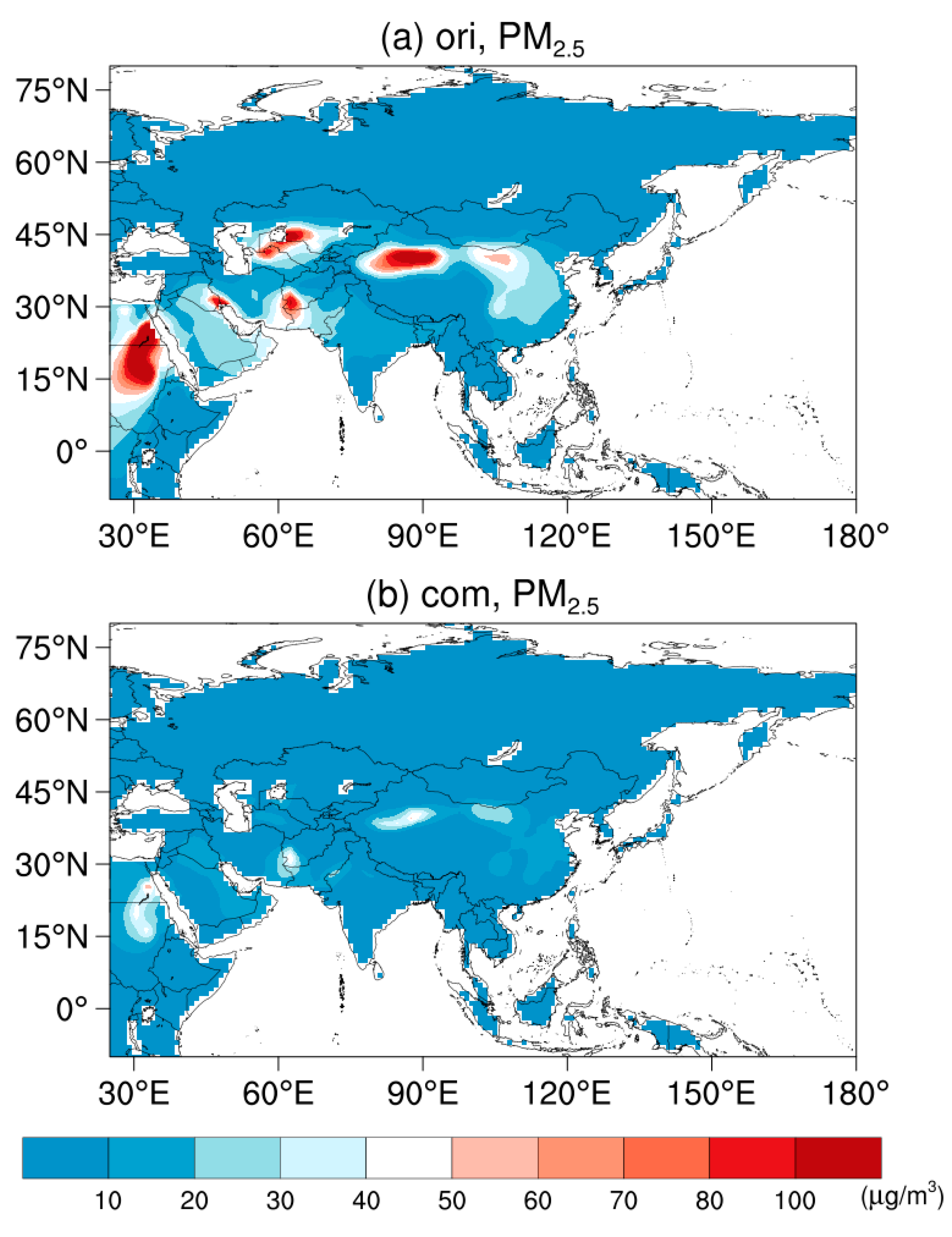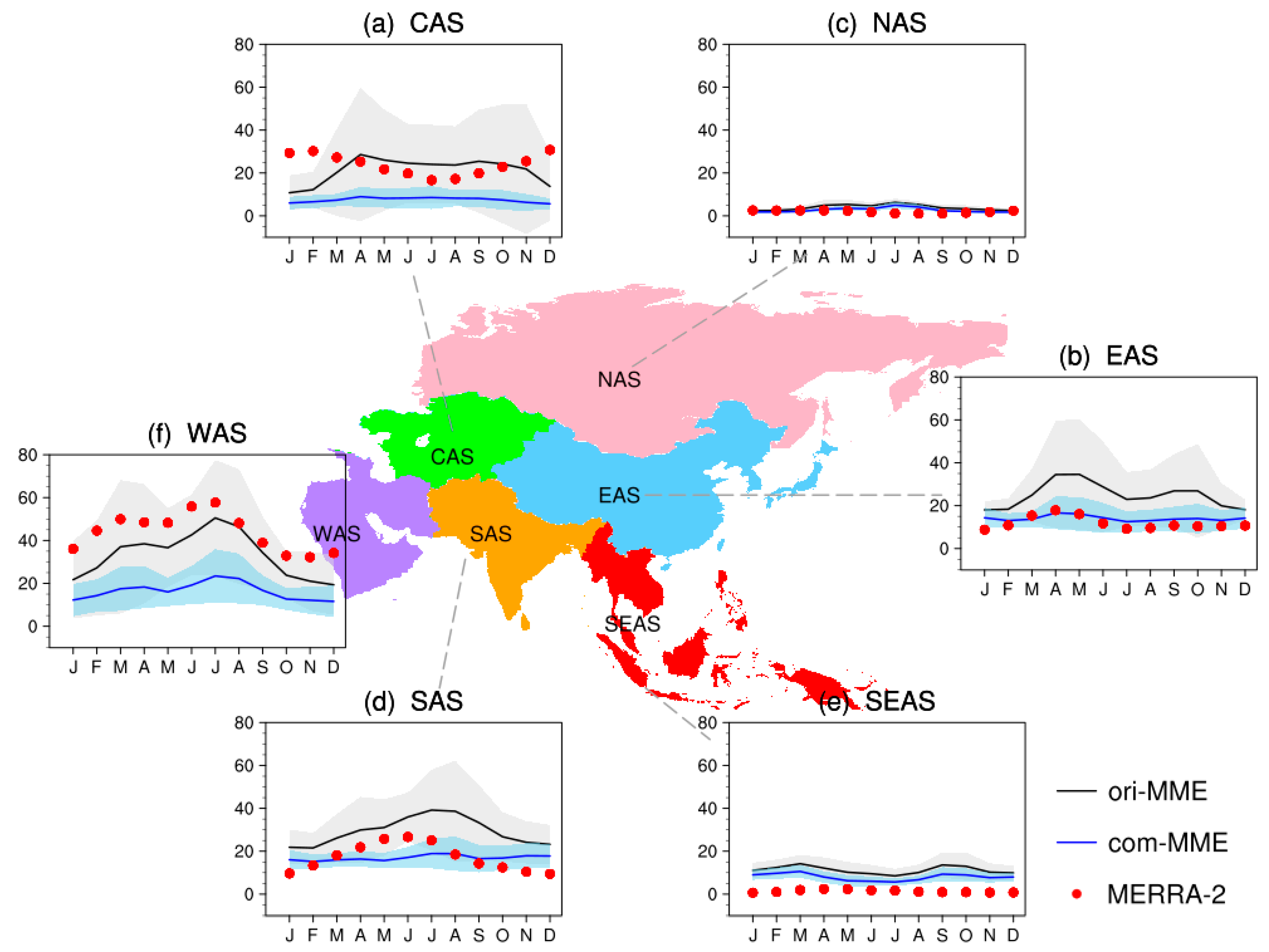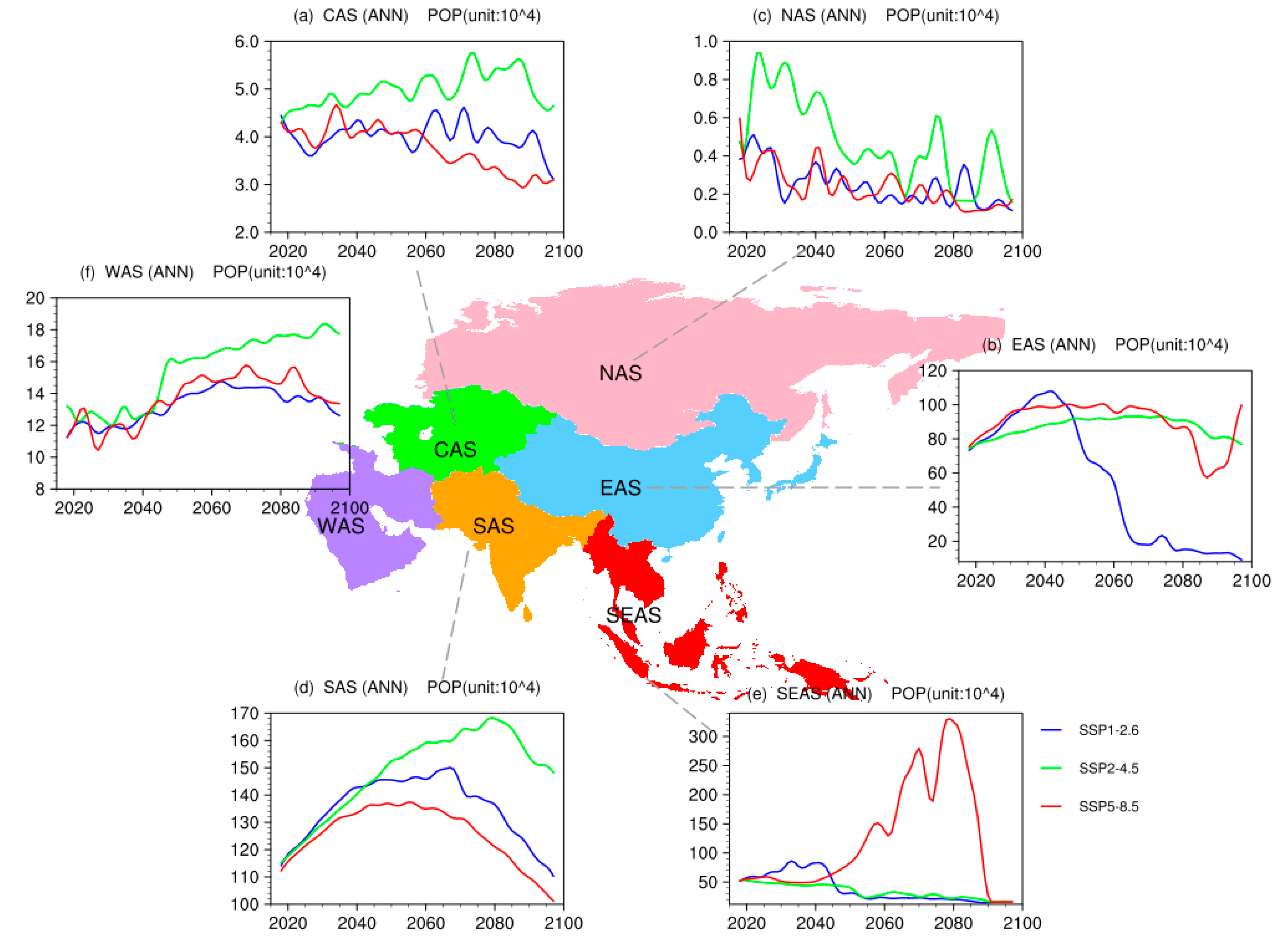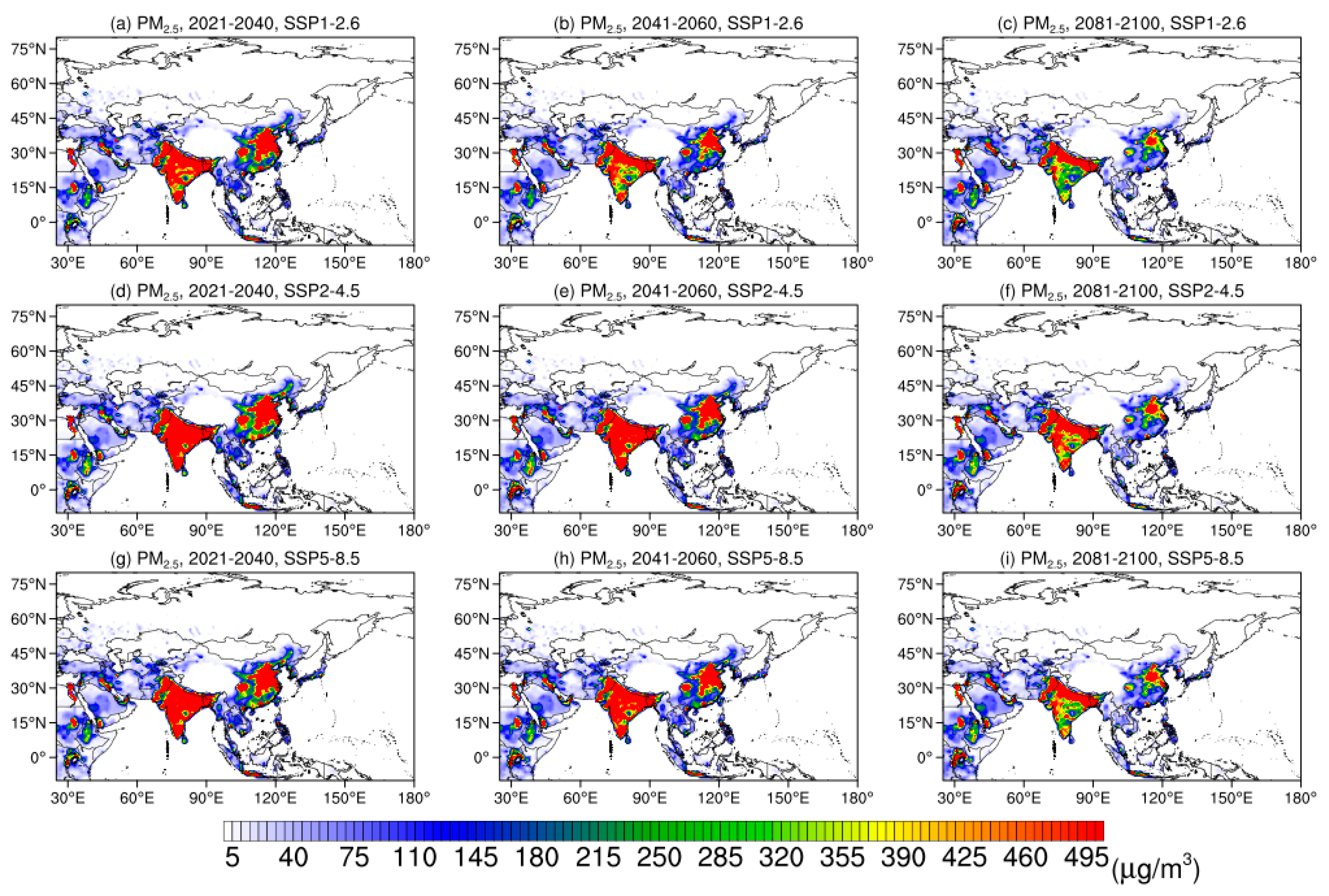Evaluation and Projection of Surface PM2.5 and Its Exposure on Population in Asia Based on the CMIP6 GCMs
Abstract
:1. Introduction
2. Data and Methods
2.1. SSP Scenarios
2.2. Observation Data Set
2.3. Surface PM2.5 in CMIP6
2.4. Conversion from Density to Mass Mixing Ratio
3. Performance of CMIP6 GCMs
4. Projection of Surface PM2.5 in Asia
5. The Impact of Surface PM2.5 over Asia on Population Exposure
6. Conclusions
- (1)
- CMIP6 models reproduce the spatial pattern of surface PM2.5 concentrations quite well. The original outputs of CMIP6 models underestimate surface PM2.5 concentrations, with a large/small model uncertainty over the areas with low/high climatic mean values of PM2.5 concentrations (NAS/Saudi Arabia, Iran, and Xinjiang Province of China). The model spread of the estimated concentrations is smaller than that from the original simulation. Generally, CMIP6 GCMs well capture the observed annual cycles and seasonal variations of surface PM2.5 concentrations in Asia.
- (2)
- Relative to the present day (1995–2014), surface PM2.5 concentrations are projected to decrease in SSP1-2.6, SSP2-4.5, and SSP5-8.5. The magnitudes and timings of changes at the regional scale are quite different. The sub-region with the sharpest fall is South Asia (SAS). Under SSP3-7.0, the increase of surface PM2.5 concentrations in SAS is the largest, with 8 μg/m3 increment by 2050; under SSP370-lowNTCF, the largest decreases of surface PM2.5 concentrations exist in SA, EAS, and SEAS. The downward trends in all seasons are consistent with that in annual trends under SSP1-2.6, SSP2-4.5, and SSP5-8.5, and the largest decreases are found in winter, with the reduction of 12 μg/m3 in SAS under SSP1-2.6 at the end of 21st century. Contrasting with the changes in other SSPs, surface PM2.5 concentrations will increase in winter under SSP3-7.0, with the biggest increment in SAS. Under SSP370-lowNTCF, surface PM2.5 concentrations in all sub-regions of Asia will decline.
- (3)
- In the weak air pollution controls pathway (SSP3-7.0), the annual mean BC concentrations are projected to increase markedly in SAS, WAS, and EAS. The concentrations will decrease gradually in other SSPs. Annual and seasonal mean dust concentrations show the obvious interannual variation over WAS, CAS, SAS, and EAS. Downward trends of SO4 are found in most parts of Asia under most SSPs. Larger changes in OA are found mainly in SAS, SEAS, and EAS. SS mainly distributes in coastal areas, with a gradual increasing trend over SAS and SEAS.
- (4)
- Among all SSPs, the substantial decreases in surface PM2.5 concentrations over the whole of Asia in all time intervals are found under SSP1-2.6, with the largest declines in EAS and SAS in the late-21st century (2081–2100). Under SSP2-4.5, surface PM2.5 concentrations will increase in the early-21st century and decrease in the mid- and late-21st century; the extent in winter is larger than that in summer. Under SSP3-7.0, the area close to natural aerosol emission source (SAS) has the biggest future changes in the annual mean surface PM2.5 concentrations, with the largest increase (~30 μg/m3) in winter. The obviously seasonal variation characteristics are simulated by CMIP6 GCMs.
- (5)
- The population exposure in different sub-regions varies in different SSPs. The population exposure in EAS will increase before 2050, then decrease, with the largest downward trend in SSP1-2.6. In WAS and CAS, the population exposure will continue to grow, and decrease slightly under SSP2-4.5. After 2050, the downward trends are found in all sub-regions under SSP1-2.6 and SSP5-8.5, with the largest trend in SAS. In SEAS, the population exposure will decline in SSP1-2.6 and SSP2-4.5; in SSP5-8.5, it shows a sudden rise after 2050 and a rapid decline around 2085.
- (6)
- The population-weighted surface PM2.5 concentrations show downward trends over CAS, EAS, NAS, and SEAS and an increasing trend over WAS under three SSPs. Although they gradually decrease in SAS after 2040, the amount of PM2.5 in this sub-region is larger than that in other sub-regions, which is linked to the large population in India.
7. Discussion
Supplementary Materials
Author Contributions
Funding
Institutional Review Board Statement
Informed Consent Statement
Data Availability Statement
Acknowledgments
Conflicts of Interest
References
- Lelieveld, J.; Evans, J.S.; Fnais, M.; Giannadaki, D.; Pozzer, A. The contribution of outdoor air pollution sources to premature mortality on a global scale. Nature 2015, 525, 367–371. [Google Scholar] [CrossRef] [PubMed]
- Butt, E.W.; Turnock, S.T.; Rigby, R.; Reddington, C.L.; Yoshioka, M.; Johnson, J.S.; Regayre, L.A.; Pringle, K.J.; Mann, G.W.; Spracklen, D.V. Global and regional trends in particulate air pollution and attributable health burden over the past 50 years. Environ. Res. Lett. 2017, 12, 104017. [Google Scholar] [CrossRef]
- Cohen, A.J.; Brauer, M.; Burnett, R.; Anderson, H.R.; Frostad, J.; Estep, K.; Balakrishnan, K.; Brunekreef, B.; Dandona, L.; Dandona, R.; et al. Estimates and 25-year trends of the global burden of disease attributable to ambient air pollution: An analysis of data from the Global Burden of Diseases Study 2015. Lancet 2017, 389, 1907–1918. [Google Scholar] [CrossRef]
- Apte, J.S.; Marshall, J.D.; Cohen, A.J.; Brauer, M. Addressing global mortality from ambient PM2.5. Environ. Sci. Technol. 2015, 49, 8057–8066. [Google Scholar] [CrossRef]
- Malley, C.S.; Henze, D.K.; Kuylenstierna, J.C.I.; Vallac, K.H.W.; Davila, Y.; Anenberg, S.C.; Turner, M.C.; Ashmore, M.R. Updated global estimates of respiratory mortality in adults ≥30 years of age attributable to long-term ozone exposure. Environ. Health Perspect. 2017, 125, 087021. [Google Scholar] [CrossRef]
- EPA. U.S. Integrated Science Assessment (ISA) for Particulate Matter; Agency USEP, Ed.; US Environmental Protection Agency: Washington, DC, USA, 2019.
- Forouzanfar, M.H.; Alexander, L.; Anderson, H.R.; Bachman, V.F.; Biryukov, S.; Brauer, M.; Burnett, R.; Casey, D.; Coates, M.M.; Cohen, A.; et al. Global, regional, and national comparative risk assessment of 79 behavioural, environmental and occupational, and metabolic risks or clusters of risks in 188 countries, 1990–2013: A systematic analysis for the Global Burden of Disease Study 2013. Lancet 2015, 386, 2287–2323. [Google Scholar] [CrossRef]
- Burnett, R.; Chen, H.; Szyszkowicz, M.; Fann, N.; Hubbell, B.; Pope, C.A.; Apte, J.S.; Brauer, M.; Cohen, A.; Weichenthal, S.; et al. Global estimates of mortality associated with long-term exposure to outdoor fine particulate matter. Proc. Natl. Acad. Sci. USA 2018, 115, 9592–9597. [Google Scholar] [CrossRef] [PubMed]
- Li, T.; Guo, Y.; Liu, Y.; Wang, J.; Wang, Q.; Sun, Z.; He, M.Z.; Shi, X. Estimating mortality burden attributable to short-term PM2.5 exposure: A national observational study in China. Environ. Int. 2019, 125, 245–251. [Google Scholar] [CrossRef]
- Myhre, G.; Samset, B.H.; Schulz, M.; Balkanski, Y.; Bauer, S.; Berntsen, T.K.; Bian, H.; Bellouin, N.; Chin, M.; Diehl, T.; et al. Radiative forcing of the direct aerosol effect from AeroCom Phase II simulations. Atmos. Chem. Phys. 2013, 13, 1853–1877. [Google Scholar] [CrossRef]
- Boucher, O.; Randall, D.; Artaxo, P.; Bretherton, C.; Feingold, G.; Forster, P.; Kerminen, V.; Kondo, Y.; Liao, H.; Lohmann, U. Climate Change 2013: The Physical Science Basis. Contribution of Working Group I to the Fifth Assessment Report of the Intergovernmental Panel on Climate Change; Tignor, M.K., Allen, S.K., Boschung, J., Nauels, A., Xia, Y., Bex, V., Midgley, P.M., Eds.; Cambridge University Press: Cambridge, UK, 2013. [Google Scholar]
- Wu, J.; Xu, Y.; Zhang, B. Projection of PM2.5 and ozone concentration changes over the Jing-Jin-Ji Region in China. Atmos. Ocean. Sci. Lett. 2015, 8, 143–146. [Google Scholar]
- Wu, J. Evaluation and Projection of the Impact of Climate Change on Surface PM2.5 and Ozone Concentration over China; Chinese Academy of Meteorological Sciences: Beijing, China, 2016. [Google Scholar]
- Yang, D.; Zhang, H.; Li, J. Changes in anthropogenic PM2.5 and the resulting global climate effects under the RCP4.5 and RCP8.5 scenarios by 2050. Earth’s Future 2020, 8, e2019EF001285. [Google Scholar] [CrossRef]
- Taylor, K.E.; Stouffer, R.J.; Meehl, G.A. An overview of CMIP5 and the experiment design. Bull. Am. Meteorol. Soc. 2012, 93, 485–498. [Google Scholar] [CrossRef]
- Eyring, V.; Bony, S.; Meehl, G.A.; Senior, C.A.; Stevens, B.; Stouffer, R.J.; Taylor, K.E. Overview of the Coupled Model Intercomparison Project Phase 6 (CMIP6) experimental design and organization. Geosci. Model Dev. 2016, 9, 1937–1958. [Google Scholar] [CrossRef]
- O’Neill, B.C.; Tebaldi, C.; Vuuren, D.P.v.; Eyring, V.; Friedlingstein, P.; Hurtt, G.; Knutti, R.; Kriegler, E.; Lamarque, J.-F.; Lowe, J. The scenario model intercomparison project (ScenarioMIP) for CMIP6. Geosci. Model Dev. 2016, 9, 3461–3482. [Google Scholar] [CrossRef]
- Turnock, S.T.; Allen, R.J.; Andrews, M.; Bauer, S.E.; Deushi, M.; Emmons, L.; Good, P.; Horowitz, L.; John, J.G.; Michou, M.; et al. Historical and future changes in air pollutants from CMIP6 models. Atmos. Chem. Phys. 2020, 20, 14547–14579. [Google Scholar] [CrossRef]
- Su, X.; Wu, T.; Zhang, J.; Zhang, Y.; Jin, J.; Zhou, Q.; Zhang, F.; Liu, Y.; Zhou, Y.; Zhang, L.; et al. Present-day PM2.5 over Asia: Simulation and uncertainty in CMIP6 ESMs. J. Meteorol. Res. 2022, 36, 1–21. [Google Scholar] [CrossRef]
- Rao, S.; Klimont, Z.; Smith, S.J.; Van Dingenen, R.; Dentener, F.; Bouwman, L.; Riahi, K.; Amann, M.; Bodirsky, B.L.; van Vuuren, D.P.; et al. Future air pollution in the Shared Socio-economic Pathways. Glob. Environ. Change 2017, 42, 346–358. [Google Scholar] [CrossRef]
- Gidden, M.J.; Riahi, K.; Smith, S.J.; Fujimori, S.; Luderer, G.; Kriegler, E.; van Vuuren, D.P.; van den Berg, M.; Feng, L.; Klein, D.; et al. Global emissions pathways under different socioeconomic scenarios for use in CMIP6: A dataset of harmonized emissions trajectories through the end of the century. Geosci. Model Dev. 2019, 12, 1443–1475. [Google Scholar] [CrossRef]
- Ukhov, A.; Mostamandi, S.; da Silva, A.; Flemming, J.; Alshehri, Y.; Shevchenko, I.; Stenchikov, G. Assessment of natural and anthropogenic aerosol air pollution in the Middle East using MERRA-2, CAMS data assimilation products, and high-resolution WRF-Chem model simulations. Atmos. Chem. Phys. 2020, 20, 9281–9310. [Google Scholar] [CrossRef]
- Li, X.; Liu, Y.; Wang, M.; Jiang, Y.; Dong, X. Assessment of the Coupled Model Intercomparison Project phase 6 (CMIP6) Model performance in simulating the spatial-temporal variation of aerosol optical depth over Eastern Central China. Atmos. Res. 2021, 261, 105747. [Google Scholar] [CrossRef]
- Zhao, X.; Allen, R.J.; Thomson, E.S. An implicit air quality bias due to the state of pristine aerosol. Earth’s Future 2021, 9, e2021EF001979. [Google Scholar] [CrossRef]
- Buchard, V.; Randles, C.A.; da Silva, A.M.; Darmenov, A.; Colarco, P.R.; Govindaraju, R.; Ferrare, R.; Hair, J.; Beyersdorf, A.J.; Ziemba, L.D.; et al. The MERRA-2 aerosol reanalysis, 1980 onward. Part II: Evaluation and case studies. J. Clim. 2017, 30, 6851–6872. [Google Scholar] [CrossRef] [PubMed]
- Provençal, S.; Buchard, V.; da Silva, A.M.; Leduc, R.; Barrette, N.; Elhacham, E.; Wang, S.-H. Evaluation of PM2.5 surface concentrations simulated by version 1 of NASA’s MERRA aerosol reanalysis over Israel and Taiwan. Aerosol Air Qual. Res. 2017, 17, 253–261. [Google Scholar] [CrossRef] [PubMed]
- Hammer, M.S.; van Donkelaar, A.; Li, C.; Lyapustin, A.; Sayer, A.M.; Hsu, N.C.; Levy, R.C.; Garay, M.J.; Kalashnikova, O.V.; Kahn, R.A.; et al. Global Annual PM2.5 Grids from MODIS, MISR and SeaWiFS Aerosol Optical Depth (AOD), 1998–2019, V4.GL.03; NASA Socioeconomic Data and Applications Center (SEDAC): New York, NY, USA, 2022.
- Hammer, M.S.; van Donkelaar, A.; Li, C.; Lyapustin, A.; Sayer, A.M.; Hsu, N.C.; Levy, R.C.; Garay, M.J.; Kalashnikova, O.V.; Kahn, R.A.; et al. Global estimates and long-term trends of fine particulate matter concentrations (1998–2018). Environ. Sci. Technol. 2020, 54, 3762. [Google Scholar] [CrossRef] [PubMed]
- Jiang, D.; Sui, Y.; Lang, X. Timing and associated climate change of a 2 °C global warming. Int. J. Climatol. 2016, 36, 4512–4522. [Google Scholar] [CrossRef]
- Hoesly, R.M.; Smith, S.J.; Feng, L.; Klimont, Z.; Janssens-Maenhout, G.; Pitkanen, T.; Seibert, J.J.; Vu, L.; Andres, R.J.; Bolt, R.M.; et al. Historical (1750–2014) anthropogenic emissions of reactive gases and aerosols from the Community Emissions Data System (CEDS). Geosci. Model Dev. 2018, 11, 369–408. [Google Scholar] [CrossRef]
- Collins, W.J.; Lamarque, J.F.; Schulz, M.; Boucher, O.; Eyring, V.; Hegglin, M.I.; Maycock, A.; Myhre, G.; Prather, M.; Shindell, D.; et al. AerChemMIP: Quantifying the effects of chemistry and aerosols in CMIP6. Geosci. Model Dev. 2017, 10, 585–607. [Google Scholar] [CrossRef]
- Wu, T.; Zhang, F.; Zhang, J.; Jie, W.; Zhang, Y.; Wu, F.; Li, L.; Yan, J.; Liu, X.; Lu, X.; et al. Beijing Climate Center Earth System Model version 1 (BCC-ESM1): Model description and evaluation of aerosol simulations. Geosci. Model Dev. 2020, 13, 977–1005. [Google Scholar] [CrossRef]
- Zhang, J.; Wu, T.W.; Zhang, F.; Furtado, K.; Xin, X.G.; Shi, X.L.; Li, J.L.; Chu, M.; Zhang, L.; Liu, Q.X.; et al. BCC-ESM1 Model Datasets for the CMIP6 Aerosol Chemistry Model Intercomparison Project (AerChemMIP). Adv. Atmos. Sci. 2021, 38, 317–328. [Google Scholar] [CrossRef]
- Dunne, J.P.; Horowitz, L.W.; Adcroft, A.J.; Ginoux, P.; Held, I.M.; John, J.G.; Krasting, J.P.; Malyshev, S.; Naik, V.; Paulot, F.; et al. The GFDL Earth System Model version 4.1 (GFDL-ESM 4.1): Overall coupled model description and simulation characteristics. J. Adv. Model. Earth Syst. 2020, 12, e2019MS002015. [Google Scholar] [CrossRef]
- Krasting, J.P.; Stouffer, R.J.; Griffies, S.M.; Hallberg, R.W.; Malyshev, S.L.; Samuels, B.L.; Sentman, L.T. Role of ocean model formulation in climate response uncertainty. J. Clim. 2018, 31, 9313–9333. [Google Scholar] [CrossRef]
- Bauer, S.E.; Tsigaridis, K.; Faluvegi, G.; Kelley, M.; Lo, K.K.; Miller, R.L.; Nazarenko, L.; Schmidt, G.A.; Wu, J. Historical (1850–2014) aerosol evolution and role on climate forcing using the GISS ModelE2.1 contribution to CMIP6. J. Adv. Model. Earth Syst. 2020, 12, e2019MS001978. [Google Scholar] [CrossRef]
- Sepulchre, P.; Caubel, A.; Ladant, J.B.; Bopp, L.; Boucher, O.; Braconnot, P.; Brockmann, P.; Cozic, A.; Donnadieu, Y.; Dufresne, J.L.; et al. IPSL-CM5A2—An Earth system model designed for multi-millennial climate simulations. Geosci. Model Dev. 2020, 13, 3011–3053. [Google Scholar] [CrossRef]
- Boucher, O.; Servonnat, J.; Albright, A.L.; Aumont, O.; Balkanski, Y.; Bastrikov, V.; Bekki, S.; Bonnet, R.; Bony, S.; Bopp, L.; et al. Presentation and evaluation of the IPSL-CM6A-LR climate model. J. Adv. Model. Earth Syst. 2020, 12, e2019MS002010. [Google Scholar] [CrossRef]
- Tegen, I.; Neubauer, D.; Ferrachat, S.; Siegenthaler-Le Drian, C.; Bey, I.; Schutgens, N.; Stier, P.; Watson-Parris, D.; Stanelle, T.; Schmidt, H.; et al. The global aerosol–climate model ECHAM6.3–HAM2.3—Part 1: Aerosol evaluation. Geosci. Model Dev. 2019, 12, 1643–1677. [Google Scholar] [CrossRef]
- Neubauer, D.; Ferrachat, S.; Siegenthaler-Le Drian, C.; Stoll, J.; Folini, D.S.; Tegen, I.; Wieners, K.-H.; Mauritsen, T.; Stemmler, I.; Barthel, S.; et al. HAMMOZ-Consortium MPI-ESM1.2-HAM model output prepared for CMIP6 AerChemMIP. Earth Syst. Grid Fed. 2019. [Google Scholar] [CrossRef]
- Takemura, T. Distributions and climate effects of atmospheric aerosols from the preindustrial era to 2100 along Representative Concentration Pathways (RCPs) simulated using the global aerosol model SPRINTARS. Atmos. Chem. Phys. 2012, 12, 11555–11572. [Google Scholar] [CrossRef]
- Tatebe, H.; Ogura, T.; Nitta, T.; Komuro, Y.; Ogochi, K.; Takemura, T.; Sudo, K.; Sekiguchi, M.; Abe, M.; Saito, F.; et al. Description and basic evaluation of simulated mean state, internal variability, and climate sensitivity in MIROC6. Geosci. Model Dev. 2019, 12, 2727–2765. [Google Scholar] [CrossRef]
- Yukimoto, S.; Kawai, H.; Koshiro, T.; Oshima, N.; Yoshida, K.; Urakawa, S.; Tsujino, H.; Deushi, M.; Tanaka, T.; Hosaka, M.; et al. The Meteorological Research Institute Earth System Model version 2.0, MRI-ESM2.0: Description and basic evaluation of the physical component. J. Meteorol. Soc. Jpn. Ser. II 2019, 97, 931–965. [Google Scholar] [CrossRef]
- Kirkevåg, A.; Grini, A.; Olivié, D.; Seland, Ø.; Alterskjær, K.; Hummel, M.; Karset, I.H.H.; Lewinschal, A.; Liu, X.; Makkonen, R.; et al. A production-tagged aerosol module for Earth system models, OsloAero5.3—Extensions and updates for CAM5.3-Oslo. Geosci. Model Dev. 2018, 11, 3945–3982. [Google Scholar] [CrossRef]
- Tsigaridis, K.; Daskalakis, N.; Kanakidou, M.; Adams, P.J.; Artaxo, P.; Bahadur, R.; Balkanski, Y.; Bauer, S.E.; Bellouin, N.; Benedetti, A.; et al. The AeroCom evaluation and intercomparison of organic aerosol in global models. Atmos. Chem. Phys. 2014, 14, 10845–10895. [Google Scholar] [CrossRef] [Green Version]
- Pan, X.; Chin, M.; Gautam, R.; Bian, H.; Kim, D.; Colarco, P.R.; Diehl, T.L.; Takemura, T.; Pozzoli, L.; Tsigaridis, K.; et al. A multi-model evaluation of aerosols over South Asia: Common problems and possible causes. Atmos. Chem. Phys. 2015, 15, 5903–5928. [Google Scholar] [CrossRef]
- Glotfelty, T.; He, J.; Zhang, Y. Impact of future climate policy scenarios on air quality and aerosol-cloud interactions using an advanced version of CESM/CAM5: Part I. model evaluation for the current decadal simulations. Atmos. Environ. 2017, 152, 222–239. [Google Scholar] [CrossRef]
- Solazzo, E.; Bianconi, R.; Hogrefe, C.; Curci, G.; Tuccella, P.; Alyuz, U.; Balzarini, A.; Baró, R.; Bellasio, R.; Bieser, J.; et al. Evaluation and error apportionment of an ensemble of atmospheric chemistry transport modeling systems: Multivariable temporal and spatial breakdown. Atmos. Chem. Phys. 2017, 17, 3001–3054. [Google Scholar] [CrossRef]
- Im, U.; Brandt, J.; Geels, C.; Hansen, K.M.; Christensen, J.H.; Andersen, M.S.; Solazzo, E.; Kioutsioukis, I.; Alyuz, U.; Balzarini, A.; et al. Assessment and economic valuation of air pollution impacts on human health over Europe and the United States as calculated by a multi-model ensemble in the framework of AQMEII3. Atmos. Chem. Phys. 2018, 18, 5967–5989. [Google Scholar] [CrossRef] [PubMed] [Green Version]
- Prather, M.; Ehhalt, D.; Dentener, F.; Derwent, R.; Dlugokencky, E.; Holland, E.; Isaksen, I.; Katima, J.; Kirchhoff, V.; Matson, P.; et al. Atmospheric Chemistry and Greenhouse Gases. In Climate Change 2001: The Physical Science Basis. Contribution of Working Group I to the Third Assessment Report of the Intergovernmental Panel on Climate Change; Ding, Y., Griggs, D.J., Noguer, M., van der Linden, P.J., Dai, X., Maskell, K., Johnson, C.A., Eds.; Cambridge University Press: Cambridge, UK; New York, NY, USA, 2001; pp. 239–287. Available online: www.ipcc.ch/report/ar3/wg1.2001 (accessed on 15 September 2022).
- Naik, V.S.; Szopa, B.; Adhikary, P.; Artaxo, T.; Berntsen, W.D.; Collins, S.; Fuzzi, L.; Gallardo, A.; Kiendler Scharr, Z.; Klimont, H.; et al. Short-Lived Climate Forcers. In Climate Change 2021: The Physical Science Basis. Contribution of Working Group I to the Sixth Assessment Report of the Intergovernmental Panel on Climate Change; Masson-Delmotte, V., Zhai, A.P., Pirani, S.L., Connors, C., Péan, S., Berger, N., Caud, Y., Chen, L., Goldfarb, M.I., Gomis, M., et al., Eds.; Cambridge University Press: Cambridge, UK, 2021. [Google Scholar]
- Kirtman, B.; Power, S.B.; Adedoyin, A.J.; Boer, G.J.; Bojariu, R.; Camilloni, I.; Doblas-Reyes, F.; Fiore, A.M.; Kimoto, M.; Meehl, G.; et al. Near-term climate change: Projections and predictability. In Climate Change 2013: The Physical Science Basis. Contribution of Working Group I to the Fifth Assessment Report of the Intergovernmental Panel on Climate Change; Cambridge University Press: Cambridge, UK, 2013; pp. 953–1028. [Google Scholar]








| Model | Present Day | SSP1-2.6 | SSP2-4.5 | SSP3-7.0 | SSP370-lowNTCF | SSP5-8.5 | Horizontal Resolution (Longitude × Latitude) | Institute and Country; Data Citation |
|---|---|---|---|---|---|---|---|---|
| BCC-ESM1 | * | * | * | 2.813° × 2.813° | Beijing Climate Center (BCC), China; [32,33] | |||
| GFDL-ESM4 | √ * | √ * | √ * | √ * | √ * | √ * | 1.0° × 1.25° | Geophysical Fluid Dynamics Laboratory (GFDL), United States; [34,35] |
| GISS-E2-1-G | √ * | √ | √ * | √ * | √ | 2.5° × 2° | Goddard Institute for Space Studies (GISS), United States; [36] | |
| GISS-E2-1-H | √ * | √ | √ * | √ * | √ * | √ * | 2.5° × 2° | Goddard Institute for Space Studies (GISS), United States; [36] |
| IPSL-CM5A2-INCA | * | * | * | 3.75° × 2.813° | Institute Pierre-Simon Laplace (IPSL), France; [37,38] | |||
| MPI-ESM-1-2-HAM | * | * | * | 1.875° × 1.875° | Max Planck Institute (MPI) for Meteorology, Germany; [39,40] | |||
| MIROC-ES2L | √ * | √ * | √ * | * | * | 2.813° × 2.813° | The University of Tokyo, Japan; [41] | |
| MIROC6 | √ * | √ * | √ * | √ * | * | √ * | 1.406° × 1.406° | Model for Interdisciplinary Research onClimate (MIROC), Japan; [42] |
| MRI-ESM2-0 | √ * | √ * | √ * | √ * | √ * | √ * | 1.125° × 1.125° | Meteorological Research Institute (MRI),Japan; [43] |
| NorESM2-LM | √ * | √ | √ | √ * | √ * | √ | 1.9° × 2.5° | Norwegian Climate Centre, Norway; [44] |
| NorESM2-MM | √ | √ | √ | √ | 0.9° × 1.25° | Norwegian Climate Centre, Norway; [44] |
Publisher’s Note: MDPI stays neutral with regard to jurisdictional claims in published maps and institutional affiliations. |
© 2022 by the authors. Licensee MDPI, Basel, Switzerland. This article is an open access article distributed under the terms and conditions of the Creative Commons Attribution (CC BY) license (https://creativecommons.org/licenses/by/4.0/).
Share and Cite
Xu, Y.; Wu, J.; Han, Z. Evaluation and Projection of Surface PM2.5 and Its Exposure on Population in Asia Based on the CMIP6 GCMs. Int. J. Environ. Res. Public Health 2022, 19, 12092. https://doi.org/10.3390/ijerph191912092
Xu Y, Wu J, Han Z. Evaluation and Projection of Surface PM2.5 and Its Exposure on Population in Asia Based on the CMIP6 GCMs. International Journal of Environmental Research and Public Health. 2022; 19(19):12092. https://doi.org/10.3390/ijerph191912092
Chicago/Turabian StyleXu, Ying, Jie Wu, and Zhenyu Han. 2022. "Evaluation and Projection of Surface PM2.5 and Its Exposure on Population in Asia Based on the CMIP6 GCMs" International Journal of Environmental Research and Public Health 19, no. 19: 12092. https://doi.org/10.3390/ijerph191912092
APA StyleXu, Y., Wu, J., & Han, Z. (2022). Evaluation and Projection of Surface PM2.5 and Its Exposure on Population in Asia Based on the CMIP6 GCMs. International Journal of Environmental Research and Public Health, 19(19), 12092. https://doi.org/10.3390/ijerph191912092






